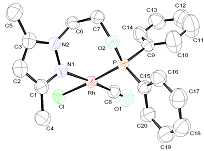Characterization of two new ligands and their reactivity towards Rh (I)

Ligands are either atoms, ions, or molecules that bond to a central metal, generally involving formal donation of one or more of its electrons. In this research, scientists have synthesized and characterized two new ligands N-pirazole and P-phosfinite and studied their reactivity towards Rh (I), obtaining new crystalline structures by X-ray diffraction.
During the last century the interest for the coordination and the organometallic chemistry has increased impressively. The potential applicability of complexes where the metal is coordinated to organic ligands by a heteroatom (N, O, S, P, etc) has focused the interest of many laboratories [i, ii, iii]. In particular, ligands with two or more different heteroatoms have been studied for its potential hemilabile properties [iv, v]. Our group has previously reported several functionalized thioether-, amino- and phosphino- containing pyrazole ligands [vi, vii, viii ] and we have studied their reaction with Pd(II), Pt(II) and Rh(I).
During the last years the phosphinite group [P(OR)R’2] has experimented an important attention in the coordination chemistry for its capability to modulate electronic and steric properties against phosphines [PR3 ] and many utilities have been investigated [ix]. Following the interest of hybrid ligands, our group has recently published a paper with the synthesis and characterisation of two N-pyrazole, P-phosphinite ligands and its reaction towards Ru(II) [x].
In this paper, two new N-pyrazole, P-phosphinite hybrid ligands, (Figure 1) have been synthesised and characterised. The reaction of these ligands towards Rh(I) complex has been studied and complexes with formula [RhCl(CO)L] have been obtained (figure 2). All complexes are fully characterised by analytical and spectroscopic methods and the resolution of two crystalline structures by single crystal X-ray diffraction methods are also presented. In these complexes, the ligands are coordinated via κ2 (N,P) to Rh(I), forming metallocycles of seven or eight members and finish its coordination with a carbonyl monoxide (CO) and a trans-chlorine to phosphorus atom. Weak intermolecular interactions are also detected and studied. NMR studies of complexes in solution corroborate the solid data.
i J. L. Sessler, E. Tomat, Acc. Chem. Res. 40 (2007) 371.
ii V. Marin, E. Holder, R. Hoogenboom, U. S. Schubert, Chem. Soc. Rev. 36 (2007) 618.
iii B. Breit, Angew. Chem., Int. Ed. 44 (2005) 6816.
iv M. Bassetti, Eur. J. Inorg. Chem. (2006) 4473.
v P. Braunstein, F. Naud, Angew. Chem., Int. Ed. 40 (2001) 680.
vi A. de León, J. Pons, J. García-Antón, X. Solans, M. Font-Bardía, J. Ros, Inorg. Chim. Acta 360 (2007) 2071.
vii A. Rimola, M. Sodupe, J. Ros, J. Pons, Eur. J. Inorg. Chem. (2006) 447.
viii A. Pañella, J. Pons, X. Solans, M. Font-Bardía, J. Ros, Eur. J. Inorg. Chem. (2006) 1678.
ix F. Agbossou-Niedercorn, I. Suisse, Coord. Chem. Rev. 242 (2003) 145.
x R. Tribó, S. Muñoz, J. Pons, R. Yáñez, A. Alvarez-Larena, J. F. Piniella, J. Ros, J. Organomet. Chem. 690 (2005) 4072.
References
"New N-pyrazole, P-phosphinite hybrid ligands and corresponding Rh(I) complexes: X-ray crystal structures of complexes with [Rh, N, P-phosphinite, Cl, (CO)] core". Munoz, S; Pons, J; Solans, X; Font-Bardia, M; Ros, J. JOURNAL OF ORGANOMETALLIC CHEMISTRY, 693 (12): 2132-2138 JUN 1 2008.

